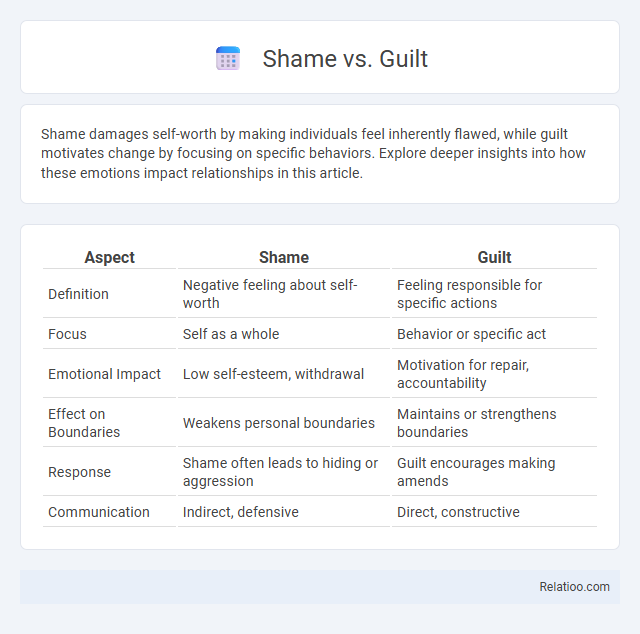Shame damages self-worth by making individuals feel inherently flawed, while guilt motivates change by focusing on specific behaviors. Explore deeper insights into how these emotions impact relationships in this article.
Table of Comparison
| Aspect | Shame | Guilt |
|---|---|---|
| Definition | Negative feeling about self-worth | Feeling responsible for specific actions |
| Focus | Self as a whole | Behavior or specific act |
| Emotional Impact | Low self-esteem, withdrawal | Motivation for repair, accountability |
| Effect on Boundaries | Weakens personal boundaries | Maintains or strengthens boundaries |
| Response | Shame often leads to hiding or aggression | Guilt encourages making amends |
| Communication | Indirect, defensive | Direct, constructive |
Understanding Shame and Guilt: Key Definitions
Shame involves a painful feeling of being inherently flawed or unworthy, often leading to withdrawal and low self-esteem, whereas guilt arises from specific actions or behaviors that violate personal or social standards, prompting feelings of remorse and a desire to make amends. Understanding shame focuses on the negative self-evaluation and the global sense of defectiveness, while guilt centers on accountability and the recognition of wrongdoing without diminishing self-worth. Distinguishing these emotions is crucial for mental health professionals to develop effective therapeutic approaches that address self-identity and behavioral change.
Origins: How Shame and Guilt Develop
Shame and guilt originate from early childhood experiences and social interactions that shape emotional responses to behavior. Shame arises from the perception of being flawed as a person, often linked to harsh or critical parental feedback, while guilt stems from recognizing specific actions as wrong, prompting a desire to make amends. Understanding your emotional origins helps differentiate these feelings and supports healthier self-awareness and emotional regulation.
Emotional Experience: What Shame Feels Like vs What Guilt Feels Like
Shame triggers an intense feeling of being fundamentally flawed and unworthy, causing You to feel exposed and trapped within Yourself. Guilt focuses on specific actions or behaviors, prompting a desire to make amends and improve Your conduct. Understanding these emotional experiences helps differentiate shame as a painful self-judgment, while guilt acts as a motivating force for personal growth.
Psychological Impact: Effects on Mental Health
Shame triggers feelings of worthlessness and self-condemnation, often leading to depression and social withdrawal, while guilt focuses on specific behaviors, promoting reparative actions and healthier emotional processing. Persistent shame can exacerbate anxiety disorders, increase vulnerability to substance abuse, and contribute to chronic stress, whereas guilt is linked to motivation for personal growth and accountability. Understanding the nuanced psychological impacts of shame and guilt assists mental health professionals in designing targeted therapeutic interventions to improve emotional resilience.
Shame vs Guilt: Behavioral Responses
Shame triggers avoidance and withdrawal behaviors as individuals feel exposed and unworthy, often leading to social isolation. Guilt prompts reparative actions, motivating people to acknowledge mistakes and actively seek forgiveness or make amends. Understanding these distinct behavioral responses is crucial for addressing emotional regulation and improving interpersonal relationships.
Social and Cultural Influences
Shame and guilt are distinct emotions shaped significantly by social and cultural contexts, where shame often arises from perceived failures to meet communal or societal expectations, and guilt stems from personal moral judgments about specific actions. Collectivist cultures tend to emphasize shame as a mechanism to maintain social harmony and group cohesion, reinforcing behaviors that align with cultural norms. In contrast, individualistic cultures highlight guilt, focusing on personal responsibility and internalized ethical standards, reflecting divergent socialization processes.
Adaptive vs Maladaptive Outcomes
Shame involves a negative evaluation of the self, often leading to maladaptive outcomes like social withdrawal and decreased self-esteem, whereas guilt focuses on specific behaviors, promoting adaptive outcomes such as reparative actions and personal growth. Adaptive guilt encourages responsibility and constructive change, while maladaptive shame can result in chronic feelings of worthlessness and hinder emotional well-being. Understanding the difference allows you to foster healthier coping mechanisms by addressing behaviors rather than self-worth.
Overcoming Shame and Guilt: Practical Strategies
Overcoming shame and guilt involves recognizing their origins and differentiating between the two emotions to address them effectively. You can practice self-compassion, challenge negative self-beliefs, and seek therapy techniques such as cognitive-behavioral therapy to reframe thoughts that fuel shame or guilt. Developing open communication and setting realistic personal standards further supports emotional healing and resilience.
Shame and Guilt in Relationships
Shame in relationships often leads to feelings of worthlessness and isolation, causing you to withdraw and avoid vulnerability, whereas guilt focuses on specific actions and encourages taking responsibility and making amends. Understanding the difference between shame and guilt helps improve communication and emotional intimacy by fostering accountability without damaging self-esteem. Recognizing how these emotions affect your interactions can build stronger, more empathetic connections with your partner.
Conclusion: Embracing Growth Through Self-Compassion
Shame and guilt differ fundamentally: shame targets the self as flawed, while guilt targets specific actions, fostering responsibility. Embracing growth through self-compassion transforms guilt into a constructive force that encourages learning and change rather than self-condemnation. Cultivating self-compassion diminishes shame's destructive impact, promoting emotional resilience and healthier relationships.

Infographic: Shame vs Guilt
 relatioo.com
relatioo.com